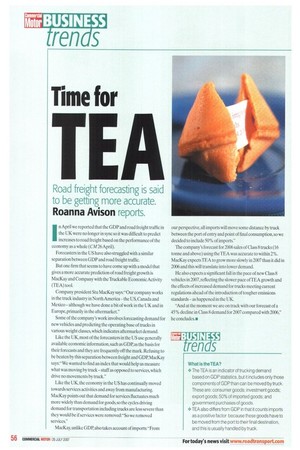Time for
Page 56

If you've noticed an error in this article please click here to report it so we can fix it.
In April we reported that the GDP and road freight traffic in the UK were no longer in sync so it was difficult to predict increases to road freight based on the performance of the economy as a whole (CM 26 April).
Forecasters in the US have also struggled with a similar separation between GDP and road freight traffic.
But one firm that seems to have come up with a model that gives a more accurate prediction of road freight growth is MacKay and Company with the Truckable Economic Activity (TEA) tool.
Company president Stu MacKay says: "Our company works in the truck industry in North America-the US, Canada and Mexico although we have done a bit of work in the UK and in Europe, primarily in the aftermarket."
Some of the company's work involves forecasting demand for new vehicles and predicting the operating base of trucks in various weight classes, which indicates aftermarket demand.
Like the UK, most of the forecasters in the US use generally available economic information, such as GDP, as the basis for their forecasts and they are frequently off the mark. Refusing to be beaten by this separation between freight and GDP, MacKay says:"We wanted to find an index that would help us measure what was moving by truckstuff as opposed to services, which drive no movements by truck."
Like the UK, the economy in the US has continually moved towards services activities and away from manufacturing. MacKay points out that demand for services fluctuates much more widely than demand for goods, so the cycles driving demand for transportation including trucks are less severe than they would be if services were removed: "So we removed services." our perspective, all imports will move some distance by truck between the port of entry and point of final consumption, so we decided to include 50% of imports."
The company's forecast for 2006 sales of Class 8 trucks (16 tonne and above) using the TEA was accurate to within 2%. MacKay expects TEA to grow more slowly in 2007 than it did in 2006 and this will translate into lower demand.
He also expects a significant fall in the pace of new Class 8 vehicles in 2007, reflecting the slower pace of TEA growth and the effects of increased demand for trucks meeting current regulations ahead of the introduction of tougher emissions standards as happened in the UK.
"And at the moment we are on track with our forecast of a 45% decline in Class 8 demand for 2007 compared with 2006," he concludes..
























































































































































































